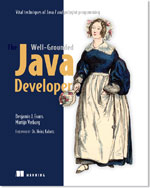The Well-Grounded Java Developer Book Review
 After finishing Core HTML5 Canvas, I dived into the next book on my list: The Well-Grounded Java Developer by Ben Evans and Martijn Verburg. I've known about this book since April of last year when I received an email from Martijn. He wanted to use some of my graphs and research on JVM Web Frameworks as evidence that many frameworks aren't meeting developer's needs and to support their coverage of Grails in the book.
After finishing Core HTML5 Canvas, I dived into the next book on my list: The Well-Grounded Java Developer by Ben Evans and Martijn Verburg. I've known about this book since April of last year when I received an email from Martijn. He wanted to use some of my graphs and research on JVM Web Frameworks as evidence that many frameworks aren't meeting developer's needs and to support their coverage of Grails in the book.
I agreed and also did a quick review on Chapter 13, Rapid Web Development. In June of this year, I received another email saying the book was done and they'd send me a free copy. I received the book in early August, but didn't start reading it until mid September.
The book is broken up into 4 separate parts:- Developing with Java 7
- Vital techniques
- Polyglot programming on the JVM
- Crafting the polyglot project
Developing with Java 7
The first two chapters on Java 7 and NIO.2 (aka JSR-203) were great in that I started learning new things immediately. While I knew about most of the changes (strings in switch statements, improved exception handling, try-with-resources, diamond syntax, etc.), it was a nice refresher and motivated me to install Java 7 and start using it on a daily basis. The NIO.2 chapter covers the new filesystem support with Path, the Files helper class and Asynchronous I/O.
It was around this same time that I started on Coursera's Functional Programming Principles in Scala. I quickly realized the course was going to take quite a bit of my free time (5-7 hours per week). It was a good challenge to try and read for 30 minutes a day as well as stay on top of my Scala homework. However, it was also highly rewarding in all the knowledge I received in the last two months.
Vital techniques
This section covers Dependency Injection, Concurrency, Class files, and Bytecode and Performance Tuning. I skimmed through the DI chapter but slowed down to try and get my head around concurrency. Then I thanked my lucky stars I haven't had to deal with it much. I found the class files and bytecode chapter mildly interesting but perked up again to learn more about how to do performance tuning, VisualVM, and the new G1 garbage collector.
Polyglot programming on the JVM
The polyglot programming section was largely a reinforcement of my existing knowledge since I've used Groovy and Scala quite a bit. The chapter on Clojure was an eye-opener since I hadn't used Clojure before. I wasn't quite convinced of its merits, but I did learn enough to read and understand its syntax. Reading the Scala chapter while doing the Coursera course made me realize that Ben and Martijn really packed a lot into each language's chapter. This section is really a great intro to all these languages, especially if you've never worked with them before.
Crafting the polyglot project
While the final section was good, I learned the least in this section. While the concepts discussed in this section are important, they're also things I've been using for years: TDD, CI, and Rapid Web Development (with Grails). This section touched on Hibernate when discussing TDD and I thought to myself - it's strange they don't have cover Hibernate (or JPA) as part of being a well-grounded Java developer. My guess is the authors assumed most Java devs already know it.
The final chapter had a lot of tips on staying well-grounded (what's coming in Java 8, how the JVM is supporting polyglot programming, future concurrency trends, and new directions in the JVM).
I really enjoyed this book and feel I became a more knowledgeable Java developer by reading it. It contained a lot of high-level concepts as well as nitty-gritty details. In my opinion, the sign of a great book is one that you feel you'll refer back to as a reference guide. The first half of this book definitely feels like something I'll refer back to. The second half I'll recommend to Java developers wanted to get caught up with the latest trends.
Nice work Ben and Martijn!

